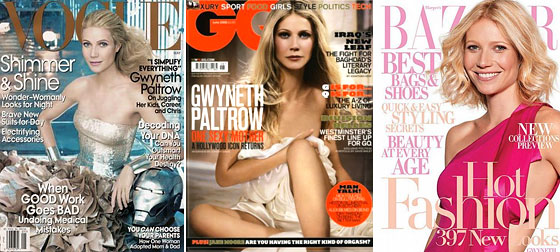It’s amazing how insular the fashion industry can be. Photographers and editors are just now realizing that perhaps, just maybe, readers would like to see less Photoshopping in magazine and advertising images. In today’s “Styles” section, the Times addresses the unretouched French Elle covers shot by Peter Lindbergh of Monica Bellucci, Sophie Marceau, and Eva Herzigova wearing no makeup. They came out last month, but hey! This is the fashion industry, and catching on to what real women want takes time to get around to. Anyway, images are routinely Photoshopped to an obscene degree. Retouchers can remove blemishes, make people thinner, eliminate cellulite, erase wrinkles and kneecaps and awkward armpit fat — you know, create fake people and pass them off to consumers as real. It’s been going on for ages, but Lindbergh has just now had enough.
“My feeling is that for years now it has taken a much too big part in how women are being visually defined today,” Mr. Lindbergh said in an e-mail exchange. “Heartless retouching,” he wrote, “should not be the chosen tool to represent women in the beginning of this century.”
It’s amazing how insular the fashion industry can be. Photographers and editors are just now realizing that perhaps, just maybe, readers would like to see less Photoshopping in magazine and advertising images. In today’s “Styles” section, the Times addresses the unretouched French Elle covers shot by Peter Lindbergh of Monica Bellucci, Sophie Marceau, and Eva Herzigova wearing no makeup. They came out last month, but hey! This is the fashion industry, and catching on to what real women want takes time to get around to. Anyway, images are routinely Photoshopped to an obscene degree. Retouchers can remove blemishes, make people thinner, eliminate cellulite, erase wrinkles and kneecaps and awkward armpit fat — you know, create fake people and pass them off to consumers as real. It’s been going on for ages, but Lindbergh has just now had enough.
“Anybody with a few days’ experience on Photoshop can drop in a new background or remove a pimple off a girl’s nose,” said Phil Poynter, who shoots campaigns for Tommy Hilfiger and editorials for Love and Pop. Still, he noted, “the big discussion in the fashion business has always been about should we retouch girls, should we create a portrait of a girl that is not achievable by a real girl.”
Probably not, unless you want to further inspire all sorts of body-image crises among impressionable women everywhere. Or, if they insist on Photoshopping so much, they should include a footnote that explains how the image was altered. France is considering passing legislation that would require magazines to disclose when and how images have been retouched. The American Society of Magazine Editors has no interest in doing that, and killed such a proposal last year.
The creative director of W said not Photoshopping pictures, like those French Elle covers, could become gimmicky. “I would not bet my life savings that it is something they are going to continue.” Well at least we won’t have to give up our favorite game — counting the number of different jawlines and other facial features they can give a single celebrity. Herewith, Gwyneth Paltrow:

From left: May 2008 Vogue, June 2008 British GQ, and July 2008 Harper’s Bazaar.




